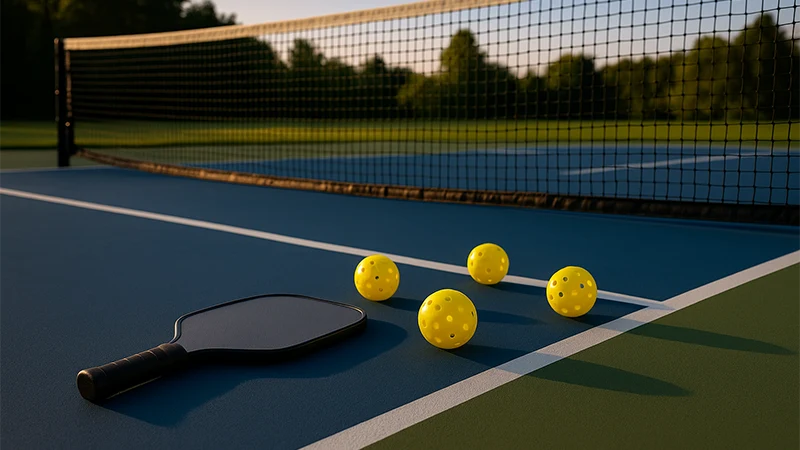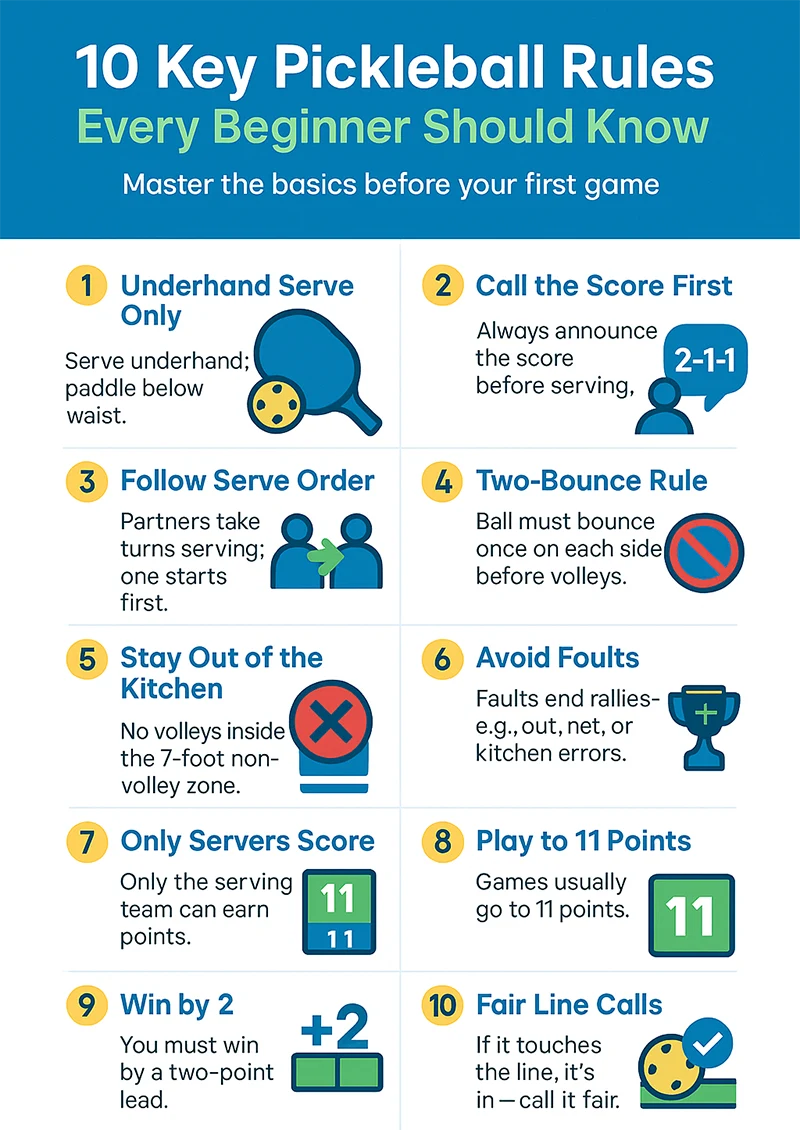Key 10 Pickleball Rules You Must Learn

CEO & Technical Expert at Pickleball Equipment Company (Art Pickleball)
Specialize in manufacturing pickleball paddles, pickleball balls, and pickleball accessories.

Pickleball, a dynamic sport blending elements of tennis, badminton, and table tennis, is rapidly gaining popularity worldwide. Its appeal lies in its easy-to-learn nature, high enjoyment factor, and suitability for players of all ages and skill levels. However, for many beginners, stepping onto the court for the first time without a firm grasp of the rules can be a major challenge, often leading to confusion and even impacting their game experience.
Don’t worry! This guide is tailor-made for you. We’ve carefully selected and compiled the key 10 pickleball rules you absolutely must learn before you play. Mastering this core knowledge will help you:
- Quickly understand game flow.
- Effectively avoid common faults.
- Enhance interaction with teammates and opponents.
- Most importantly, allow you to confidently and joyfully enjoy every match.
Ready to shed your doubts and step onto the pickleball court with confidence? Let’s dive into these essential rules and build a solid foundation for your pickleball journey!
10 Key Pickleball Rules (Simplified for Beginners)
Before diving into the details, here’s a quick summary of the 10 key pickleball rules every beginner should understand before stepping onto the court.
- Underhand Serve Only – Serve underhand with the paddle below your waist; drop serves are allowed.
- Call the Score First – Always announce the score before serving.
- Follow Serve Order – Partners take turns serving; only one player serves first.
- Two-Bounce Rule – The ball must bounce once on each side before volleys start.
- Stay Out of the Kitchen – Don’t volley while standing in the non-volley zone.
- Avoid Faults – Faults end the rally; common ones include out-of-bounds or hitting the net.
- Only Servers Score – Only the serving team can earn points.
- Play to 11 Points – Most games go to 11; some to 15 or 21.
- Win by 2 – Keep playing until one team leads by two points.
- Make Fair Line Calls – If it touches the line, it’s in — when unsure, call it in.

Now that you’ve got a quick overview of the 10 key pickleball rules, let’s dive deeper into each one.
Below, you’ll find clear explanations, examples, and beginner-friendly insights to help you understand how these rules actually work during real gameplay.
Rule 1: The Underhand Serve – Starting Every Point Legally
The underhand serve is fundamental in pickleball. It starts every point. For a legal serve, your paddle must contact the ball below your waist, and the paddle head must be below your wrist at contact.
For more detailed serving rules, refer to the USA Pickleball Official Rulebook (Rule 4.A.7.a) for the official definition and serving requirements.
The 2025 updates also introduced new serving options — see the 2025 Rule Changes Summary for the latest standards.
An alternative is the “drop serve.” Here, you drop the ball and let it bounce once before striking it. With a drop serve, the waist and wrist rules do not apply.
This rule ensures a fair start. It prevents the serving team from gaining an unfair advantage. Fair play is key for enjoyable pickleball. Understanding this rule helps maintain game integrity. It sets a level playing field for all.
Common serving mistakes include contacting the ball above your waist. Another is the paddle head being above your wrist. An inconsistent ball toss or a jerky swing can also lead to faults. These errors often result in an illegal serve — which means the point goes to the other team.
For a powerful and accurate serve, a consistent ball toss is crucial. Practice a smooth, rhythmic swing path. Focus on hitting the ball cleanly. Aim for depth and consistency, not just power. This approach builds a strong foundation.
Rule 2: Calling the Score – Your Verbal Roadmap to the Game
Properly calling the score is vital. It happens before every serve. The correct format is “Server’s Score – Opponent’s Score – Server Number.” For instance, “Two – One – One” means the serving team has two points. The receiving team has one. It’s the first server’s turn.
This practice maintains game order. It prevents confusion or arguments. It’s a cornerstone of good pickleball etiquette. A clear score call ensures everyone knows the game status. It promotes fair play and smooth transitions. All players stay on the same page.
Players often make mistakes. They might call the score too softly. Or they use the wrong number order. Forgetting the server number is also common. These errors can cause frustration. They may even lead to re-serves. This slows down the game.
Always call the score loudly and clearly. Do this before every serve. Make eye contact with your opponents. Wait for their acknowledgment. This simple habit keeps the game flowing well. It avoids many potential disagreements. It shows respect to everyone.
Rule 3: The Service Sequence – Alternating Serves & The First-Server Exception
In doubles, serves alternate between partners. When your team wins a point, the same player serves again. If your team faults, the serve passes to your partner. After both partners have served and faulted, the serve then transfers to the opposing team. In singles, the server continues until they fault. Then, the serve goes to the opponent.
At the very start of a game, there’s a unique rule. Only one player on the initial serving team serves. They serve until their team commits a fault. Once that fault occurs, the serve immediately passes to the opposing team. This is known as the “first-server exception.”
This sequence ensures fair serving opportunities. It gives all players a chance to serve. It also maintains a consistent game flow. Understanding it prevents unfair advantage. It is vital for balanced and orderly play.
Players often confuse the serving order. They might forget whose turn it is to serve. Misunderstanding the “first-server exception” is also common. These mistakes can lead to illegal serves. This interrupts the game’s rhythm.
Always remember your server number, “Server 1” or “Server 2.” Pay close attention to the score being called. Observe your opponents’ serving status. This awareness helps you avoid errors. It keeps the game running smoothly for everyone.
Rule 4: The Two-Bounce Rule – A Strategic Start to Every Rally
The “Two-Bounce Rule” is crucial. It governs the start of every point. First, the serve must bounce once in the receiving team’s court. Second, the receiving team must return the ball. This return must also bounce once in the serving team’s court. Only after these two bounces can players hit volleys. A volley is hitting the ball before it bounces.
This rule is very important. It promotes more baseline play initially. It prevents early net rushes. It creates a balanced start for both teams. Players cannot immediately dominate the net. This adds strategy to the rally’s beginning. It gives everyone a chance to position themselves.
A common mistake is volleying too early. This happens before the ball has bounced twice. Both the serving and receiving teams can make this error. Any volley before the second bounce is a fault. This results in losing the point or serve.
Use these two bounces strategically. It gives you time to adjust your court position. Move closer to the Non-Volley Zone line. Prepare for your third shot drop or drive. This setup is key for gaining an advantage. It allows you to control the net area.
Rule 5: The Non-Volley Zone (The Kitchen) – No Volleying Allowed Here
The “Non-Volley Zone” is crucial. It’s a 7-foot area on each side of the net. Players often call it “the kitchen.” You cannot hit a volley while standing in this zone. This includes stepping on the kitchen line itself. Your feet must be completely outside the zone to volley.
This rule is central to pickleball strategy. It stops players from just dominating the net. It encourages more groundstrokes and thoughtful movement. The kitchen zone ensures a more balanced game. It prevents quick, aggressive net play. This creates longer, more strategic rallies.
A very common fault is volleying in the kitchen. Players might step in while hitting the ball. Or, they might volley and then fall forward into the zone. Even touching the line after a volley is a fault. This results in losing the rally.
Stay dynamic behind the kitchen line. Wait for the ball to bounce before you enter. If you are in the kitchen, hit a groundstroke. Only volley when both feet are outside the kitchen line. This strategic positioning is key.
Rule 6: Understanding Faults – Common Ways to Lose a Rally
A “fault” is a rule violation. It instantly ends the rally. The team committing the fault loses the point. If they were serving, they lose the serve. Understanding faults is vital for play.
Faults ensure fair competition. They maintain game integrity. Knowing them prevents arguments. It helps players avoid mistakes. This keeps the game flowing smoothly.
Here are common types of faults:
- Serving Faults: The serve lands out of bounds. It fails to clear the net. It hits the non-volley zone line. An illegal serve motion is also a fault.
- Two-Bounce Rule Faults: Volleying the ball too early. This occurs before the second bounce. Both teams must wait for two bounces.
- Kitchen Zone Faults: Volleying while in the non-volley zone. Stepping into the zone after a volley is also a fault. Even touching the line counts.
- Ball Out of Bounds: The ball lands outside the court lines. This includes the baseline and sidelines. It is an immediate fault.
- Ball Hits Net and Fails to Clear: The ball touches the net. It then does not make it over to the opponent’s side. This is a fault during any rally.
- Ball Hits Player or Clothing: The ball touches any player. It also includes their clothes. This is always a fault.
Further, your paddle or body must not touch the net system. This applies while the ball is in play. If the ball hits a net post and then lands in play, it’s also a fault.
Mastering these fault rules is key. It helps you reduce your own errors. It also allows you to recognize opponent faults. This knowledge leads to more confident play.
Rule 7: Scoring a Point – Only the Serving Team Can Score
Pickleball scoring is unique. Only the team that serves can earn a point. If the serving team wins a rally, they add one point to their score. If the receiving team wins the rally, they do not score. Instead, they gain the right to serve. This is often called a “side out.”
This scoring system is fundamental. It sets pickleball apart from other racket sports. It adds a crucial strategic layer. Teams must not only win rallies. They also need to secure the serve. This encourages active play from both sides. It makes every rally meaningful.
A common error for new players is self-scoring. The receiving team might win a rally. They then mistakenly add a point to their score. Always remember this key rule. Only the serving team’s score can increase. This mistake can lead to game confusion.
Focus your strategy on winning the serve. Once you have the serve, maximize those opportunities. Work to consistently win rallies while serving. This is how you accumulate points in pickleball. Practice serving consistently and accurately. Winning the serve is just as important as scoring itself.
Rule 8: Winning Games & Matches – Reaching the Finish Line
To win a pickleball game, a team must reach 11 points. Crucially, they must also lead by at least two points. This “win by two” rule is non-negotiable. If both teams reach 10 points, play continues. The game extends until one team secures a two-point advantage.
This rule clearly defines victory conditions. It provides a definitive end to each game. Understanding it is essential for tracking scores. It helps manage game strategy. Teams know exactly what they need to achieve.
For example, a score of 11-9 is a win. If the score is 10-10, the game is not over. It might then finish 12-10, 13-11, or even higher. The two-point lead is always required. Matches are typically best of three games. This means winning two out of three games wins the match.
When nearing game or match point, stay composed. Avoid rushed shots or risky plays. Maintain focus on consistent execution. A calm approach often prevents unforced errors. This helps seal the victory.
Rule 9: No Ties in Pickleball – Playing Until a Clear Winner Emerges
Pickleball games never end in a tie. This rule is a direct extension of the “win by two” requirement. If both teams reach 10 points, the game continues. There is no predetermined cap on the final score. Play proceeds until one team establishes a two-point lead.
This rule ensures a definitive winner. It adds significant excitement to close games. Every point in an extended game is critical. It keeps players engaged until the very end. The suspense remains high.
For instance, if the score is 10-10, the game does not stop. It could then end 12-10. Or, if it continues, it might be 13-11, or 14-12. The two-point margin is the sole determinant. This can lead to thrilling, long rallies.
In tight, extended games, patience is key. Avoid becoming overly aggressive. Stick to your game plan and remain strategic. Rushing shots under pressure often leads to mistakes. A steady hand will prevail.
Rule 10: Line Calls & Fair Play – The Critical In or Out Decision
A ball that lands on any court line is considered “in.” This applies to all boundary lines. These include the baseline, sidelines, and the non-volley zone line. If any part of the ball touches the line, it is a good shot. This is a fundamental rule in pickleball.
This rule clarifies ball validity. It is crucial for fair play. Line calls are frequent during play. Correct judgments directly impact rally outcomes. Accurate calls maintain game integrity.
This applies to all court lines. A serve landing on the service line is in. A shot hitting the sideline is in. Even a shot touching the baseline is in. Players must make quick, precise decisions.
A widely accepted etiquette is: “If in doubt, call it in.” This promotes sportsmanship. If you cannot clearly see a ball as “out,” assume it is “in.” When making an “out” call, do so quickly and clearly. Respect your opponent’s calls. Avoid unnecessary arguments; fair play is paramount.
Why Mastering These Rules Will Elevate Your Pickleball Game
Understanding pickleball rules is not just about avoiding faults. It’s about unlocking your full potential on the court. Mastering these core principles profoundly impacts your game. It enhances every aspect of your playing experience.
Reduce Disputes for Smoother Play
Clear rules prevent disagreements during matches. When everyone understands the boundaries, play flows seamlessly. Knowing proper line calls or service faults avoids arguments. This creates a much more enjoyable atmosphere for all players. Fewer stoppages mean more continuous, fluid rallies. It lets you focus purely on the game itself.
Elevate Your Strategic Thinking
Rules are the framework for effective tactics. A deep understanding allows you to exploit opportunities. For instance, knowing NVZ rules influences shot placement. Understanding scoring dynamics can change your approach to game point. This knowledge empowers smarter decision-making. You can anticipate opponent moves better. It gives you a competitive edge.
Boost Enjoyment and Confidence
Playing by the rules reduces unforced errors. Avoiding common faults keeps rallies alive longer. This leads to more engaging and satisfying play. As you commit fewer errors, your confidence grows significantly. You feel more in control of the game. Enjoyment naturally increases when you play skillfully and correctly. This builds a strong foundation for improvement.
Showcase True Sportsmanship
Adhering to rules is a cornerstone of good sportsmanship. It shows respect for your opponents and the game itself. Fair play fosters a positive community environment. Upholding the integrity of pickleball benefits everyone. It ensures a level playing field. Being a good sport enhances the overall experience.
Frequently Asked Questions
Q1. What are three things you cannot do in the game of pickleball?
1. Don’t cheat your opponets.
2. Don’t put your body on the line. It’s not worth it.
3. Don’t let go of your paddle, things could get ugly.
Q2. Can you step in the kitchen before it bounces?
You can enter the kitchen only after the ball bounces inside it. If you step in and hit the ball before it bounces, that’s a fault. Simply put — volleys are not allowed in the non-volley zone, but hitting a bounced ball is perfectly fine.
Q3. What is the rule change for pickleball in 2025?
The 2025 pickleball rule updates include several new adjustments:
- Players can now use their paddle to toss the ball when serving, as long as there’s no spin.
- You may touch the kitchen with your paddle before a volley, but not with your feet.
- Players are now required to call faults for themselves and their partners.
- Spectators are no longer allowed to help with line calls during matches.
These updates were made to simplify play and make officiating clearer for everyone.
Q4. What are the basic pickleball rules?
Pickleball has a few fundamental rules that shape how the game is played:
- The serve must be underhand and diagonal, starting behind the baseline.
- The two-bounce rule applies — the ball has to bounce once on each side before volleys can begin.
- You cannot volley from the kitchen, also called the non-volley zone.
- Only the serving team can score points.
- Games are typically played to 11 points, and you must win by 2.
Q5. What is the 10 second rule in pickleball?
The 10-second rule means that once the score has been called, the server has 10 seconds to serve the ball. Taking longer than that results in a fault. This rule helps maintain a smooth rhythm and keeps the pace of the match fair and consistent.
Ready to Play? Sharpen Your Skills with Confidence!
Mastering these core pickleball rules is your first step. It’s crucial for becoming an excellent player. A solid understanding builds a strong foundation. It allows you to play effectively and fairly. Now, it’s time to put your knowledge into action.
Embrace the joy of pickleball. Apply what you’ve learned on the court. Consistent practice reinforces your understanding. It helps you enjoy every rally. Don’t be afraid to make mistakes; learning is part of the fun. Your confidence will grow with each game.
Ready to take the next step? Find local pickleball courts near you. Many communities offer public access. Consider joining a local club. Clubs provide organized play and social opportunities. You can also explore more advanced strategies — check out our Pickleball Rules: The Complete Guide (2025 Update) to master every detail before your next match. There’s always more to learn and improve.
Always remember this final advice: if any rule questions arise, consult the official USA Pickleball (USAPA) Rulebook — it’s the definitive authority. Staying updated ensures you play by the most current standards. Enjoy your pickleball journey!
